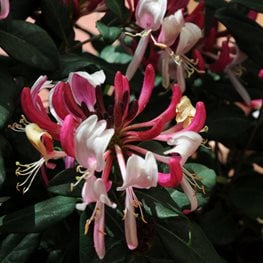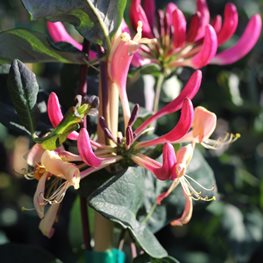GROWING HEAVENLY HONEYSUCKLE VINES
Bring breathtaking beauty to your garden with a non-invasive honeysuckle plant Updated: 3/11/2022Honeysuckle may be the queen of flowering vines, twining with abandon around arbors and archways, trellises and tree trunks, filling the air with their intoxicating scent. “If I were to have only one trellis, I’d probably plant a honeysuckle,” says Ferris Cook, author of The Garden Trellis: Designs to Build and Vines to Cultivate. “In the daytime and at night, its sweetness fills the surrounding garden, and as long as there is new growth, it continues to bloom.”
The honeysuckle genus (Lonicera) includes both vining and shrub types. Many of the shrub forms are invasive in various parts of the country and should be avoided. However, most honeysuckle vines available to home gardeners are non-invasive and can be safely grown in the landscape.
If the long-lasting, sweetly-scented flowers aren’t reason enough to grow honeysuckles, you’ll find that these versatile vines have many practical uses in the garden as well, from providing dappled shade to serving as a lush privacy screen.
On this page: Basics | Types | Growing Tips | Care & Pruning |Pictures | FAQ's | Design Ideas
On this page:
- BASICS
- TYPES OF HONEYSUCKLE
- HOW TO PLANT HONEYSUCKLE VINE
- HONEYSUCKLE VINE CARE
- HONEYSUCKLE PICTURES
- FREQUENTLY ASKED QUESTIONS
- DESIGN IDEAS
BASICS
Botanical name:
Lonicera spp.
Zones:
4 to 9
Exposure:
Full sun to partial shade
Growth habit:
Vining habit
Height/spread:
5 to 20 feet
Bloom time:
Honeysuckle season is typically May through mid-summer, with some varieties blooming into autumn.
Flowers:
Honeysuckle produces tubular flowers that grow in clusters at the branch tips, in colors from pale pastels to rich reds. Most varieties are heavily scented, with sweet nectar that is a food source for butterflies, bees, and hummingbirds. Often the flowers are followed by small red or orange berries in the fall.
Foliage:
Leaves are round or oval, growing opposite each other. Foliage can be green or blue-green, some with hints of purple or copper tones.
TYPES OF HONEYSUCKLE VINE
Common types include:
- Common honeysuckle (L. periclymenum ): Also known as woodbine, common honeysuckle is a large deciduous vine prized for its intensely fragrant multi-colored blooms. This native of Europe and Asia has become naturalized in some areas of North America, including New England and the Pacific Northwest.
- Trumpet honeysuckle (L. sempervirens): Also known as coral honeysuckle, this medium-sized semi-evergreen vine produces lightly fragrant crimson flowers that open to reveal yellow throats. This southeastern U.S. native remains evergreen in warmer regions.
- Brown's honeysuckle (L. ×brownii): This hybrid, also known as scarlet trumpet honeysuckle, combines the exotic beauty of trumpet honeysuckle with the winter hardiness of hairy honeysuckle (L. hirsuta). Orange-throated scarlet flowers are lightly fragrant, blooming from late spring through October.
- Goldflame honeysuckle (L. ×heckrottii): Goldflame honeysuckle is a medium-sized deciduous vine that produces intensely fragrant multi-colored blooms. The large open-faced flowers occur over an exceptionally long time, from summer into fall.
- Orange trumpet honeysuckle (L. ciliosa): Native to Pacific Northwest, this garden-worthy honeysuckle thrives in shade and cool climates, producing vivid orange-yellow blooms in May and June, followed by edible red berries that attract a variety of birds.
HOW TO PLANT HONEYSUCKLE VINE
When to plant:
Spring or fall. When the roots of honeysuckle vines are taking hold, they prefer cool and moist conditions. Make sure to wait until after the final frost in spring before planting honeysuckle.
Where to plant:
Choose a site with moist, well-drained soil where your honeysuckle plant will receive full sun. Although honeysuckles don’t mind some shade, they will flower more profusely in a sunny location.
How to plant:
Loosen the soil in the planting area and amend with compost or other rich organic matter. Make sure there is good drainage. Tease out roots if potbound. Dig a hole slightly larger than the root ball and place in the planting hole so the top of the root ball is level with the surrounding soil. Fill in the hole with soil, tamp down gently to remove air pockets, and water thoroughly. Water plants regularly until established.
For containers:
Make sure containers are large enough for mature plants and have adequate drainage holes. Use a high quality all-purpose potting soil that drains well.
HONEYSUCKLE VINE CARE
Temperature and humidity:
Ideal temperature range for growing honeysuckle vine is between 55 and 85 degrees F. Excessive humidity and poor air circulation can cause fungal diseases such as powdery mildew. In hotter climates, provide some afternoon shade.
Soil:
Honeysuckles also aren’t particular as to soil type or pH, but if the soil drains poorly, amend it with compost before planting so the roots won’t be sitting in standing water.
Watering:
Water thoroughly after planting, and once a week until established. Mature plants are more drought tolerant, but do best in evenly moist (not soggy) soil. Apply a layer of mulch around the root zone to retain moisture and reduce the need for watering during hot, dry conditions.
Amendments and fertilizer:
Honeysuckles don’t need big doses of fertilizer to produce a bounty of blooms. In fact, overfertilizing will often stimulate foliage growth rather than yielding more flowers. After your plants become established, an annual spring feeding with a general-purpose fertilizer is all they need.
Pruning:
Honeysuckle blooms on old or new growth, depending on the variety, so it’s important to know which kind you have.
When to prune:
- For varieties that bloom on the previous year’s growth (old growth), prune plants back by up to a third just after flowering.
- For plants that bloom on new growth, prune back to desired size in late winter or early spring.
For all honeysuckle vines, thin out congested growth and remove weak or damaged stems, which will allow for easier training. To rejuvenate older plants, hard prune plants to about 2 feet in early spring and tie in the new shoots to your support system.
Pests and diseases:
Honeysuckles are seldom troubled by serious pests or diseases, although they are susceptible to aphids and mites, which can easily be controlled with insecticidal soap. Also watch out for the development of powdery mildew on the leaves, especially in damp, humid environments. Pruning and thinning your vines to increase air circulation and light penetration are the best preventive measures.
HONEYSUCKLE VINE VARIETIES
FREQUENTLY ASKED QUESTIONS
Is honeysuckle vine invasive?
Most honeysuckle vines, with the exception of the overly aggressive Japanese honeysuckle (L. japonica), are better behaved and easier to manage, particularly the newer compact cultivars. Plants may be invasive in some regions, but not others. Japanese honeysuckle vine is especially problematic in the southeastern U.S., though not as invasive in other areas.
Many non-invasive species of honeysuckle vines have a vigorous, aggressive growth habit, which is sometimes confused with invasiveness. Because they are fast growing doesn’t make them invasive. To find out if a particular plant variety is invasive in your region, contact your local garden center or university extension service.
Is honeysuckle vine deer resistant?
Some varieties of honeysuckle vine are more deer-resistant than others. Deer tend to graze on plants in early spring when they are hungrier, preferring tender new growth. When honeysuckle is in bloom, deer are more likely to avoid the plants due to the scent, and because other food sources are more available.
Is honeysuckle poisonous?
Some types of honeysuckles contain glycosides and carotenoids which may be toxic to pets and children.
Do honeysuckle vines grow fast?
Most varieties of honeysuckle vines are quick growers, making them valuable as a screen on a fence, trellis, or arbor.
What about cape honeysuckle?
Cape honeysuckle (Tecoma capensis is a tender broadleaf evergreen shrub, not a true honeysuckle, that is related to trumpet creeper (Campsis radicans).
HONEYSUCKLE VINES IN THE GARDEN
For borders and landscapes: Plant on a fence, trellis, or arbor for a quick-growing privacy screen.
For slopes and hillsides: Use as a groundcover along a slope or hillside for erosion control.
For containers: Grow a dwarf variety in a container on a sunny patio, deck, or courtyard to enjoy the flowers and fragrance up close.
- Plant honeysuckles where their sweet perfume can be fully appreciated, such as by a door or window, over an arched gateway, or twining through an arbor or pergola over a deck (see Vines for Arbors).
- To create a beautiful tableau of colors and fragrances, intermingle honeysuckles with other flowering vines, such as clematis, climbing roses, jasmine, climbing hydrangea, and perennial peas (Lathyrus latifolius).
- Use honeysuckles to hide an old tree stump by encircling the stump with wire netting that the vines can climb on. The same technique can be used to cover a lamppost or downspout.
- Allow honeysuckles to weave through a chain-link or latticework fence to form a natural privacy screen. This is also an effective way to disguise an older fence that has become an eyesore.
- If you don't have a trellis or other vertical support, let your honeysuckles meander over the ground to create a luxurious floral carpet. They can also be grown on slopes to control erosion or draped over retaining walls.
- In addition to attracting hummingbirds to your garden, you can also use honeysuckles to establish a backyard habitat for a variety of songbirds. Their dense growth provides a thicket in which many birds love to nest while foraging on the colorful berries.
RELATED:
Flowering Vines
20 Fragrant Flowering Plants
Passion Flowers
Wisteria Vines














